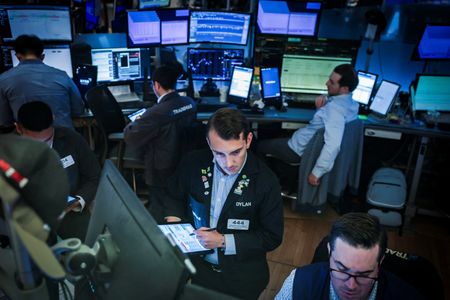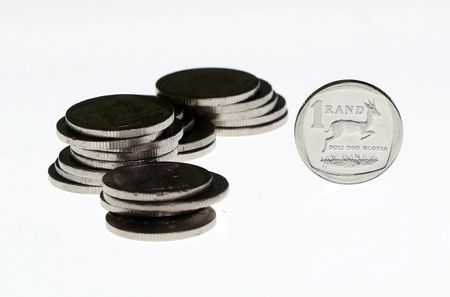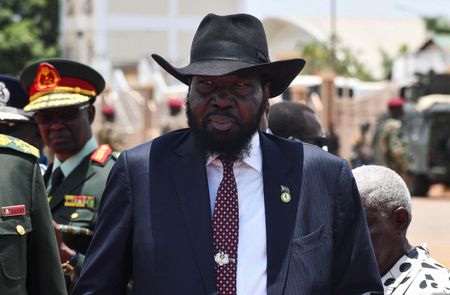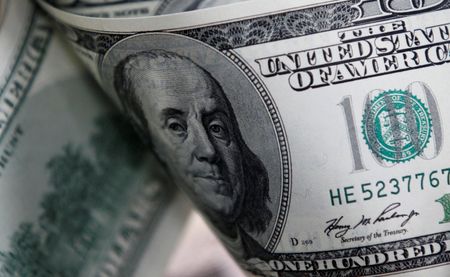By Karen Brettell
NEW YORK (Reuters) -The dollar dropped broadly on Friday after Federal Reserve Chair Jerome Powell pointed to a possible rate cut at the central bank’s September meeting but stopped short of committing to such a move.
The dollar index, which measures the greenback against a basket of currencies including the yen and the euro, was last down 0.96% on the day at 97.66, after trading around 98.7 before Powell’s comments.
The euro gained 1.06% to $1.1728 and reached $1.1742, the highest since July 28. Against the Japanese yen, the dollar weakened 1.08% to 146.77.
“While the labor market appears to be in balance, it is a curious kind of balance that results from a marked slowing in both the supply of and demand for workers. This unusual situation suggests that downside risks to employment are rising,” Powell said.
“And if those risks materialize, they can do so quickly,” he told an audience of international economists and policymakers at the Fed’s annual conference in Jackson Hole, Wyoming.
Karl Schamotta, chief market strategist at Corpay in Toronto, said Powell’s message was far more dovish than markets had anticipated.
“The dollar is plunging, odds on a September rate cut are rising and market participants are clearly bracing for more easing to come,” he said.
Traders are now pricing in 85% odds of an interest rate cut at the Fed’s September 16-17 policy meeting, up from 72% earlier on Friday, according to the CME Group’s FedWatch Tool. They are also pricing in 54 basis points of cuts by year-end, up from 48 basis points.
“The burden of proof is now clearly on the data to prevent a September cut,” Bank of America economists said in a report on Friday.
Traders had been raising their expectations for a cut in September after an unexpectedly weak jobs report for July. Consumer price data showing limited inflation increases from tariffs so far added to the view.
But hotter-than-expected producer price inflation and some other economic releases, including a strong business activity survey for August, had led them to temper their view.
Now, labor market data is expected to be the main driver of Fed policy going forward.
“What he’s really saying there is that they are bracing for a pivot in labor market conditions and that the second half of the Fed’s mandate has suddenly become much, much more important in terms of defining policy settings,” said Schamotta.
The dollar was headed on Friday for its largest daily loss against the euro and yen since August 1, when the July jobs report was released.
The dollar has also been under pressure at times this week on concerns about Fed independence after U.S. President Donald Trump indicated he may seek to fire Fed Governor Lisa Cook.
Trump on Friday said he would fire Cook if she doesn’t resign, after calling for her resignation on Wednesday on the basis of allegations about mortgages she holds in Michigan and Georgia.
“Trump’s words on Cook… are once again raising concerns over the Fed’s independence as it becomes more clear the administration may be looking to remake the Fed in its own image,” said Helen Given, FX trader at Money USA in Washington.
Trump has repeatedly criticized Powell for being too slow to cut rates, and traders expect he will replace Powell with a more dovish appointment when his term ends in May.
But Powell may stay on the board of governors, which would limit how many appointments Trump may make and could crimp plans to form a more dovish composition of policymakers unless there are more departures.
In other currencies, sterling strengthened 0.86% to $1.3527. The Australian dollar gained 1.14% versus the greenback to $0.6492.
In cryptocurrencies, bitcoin gained 4.10% to $117,035.
(Reporting by Karen Brettell; Additional reporting by Laura Matthews; Editing by Chizu Nomiyama, Clelia Oziel and Andrea Ricci)










